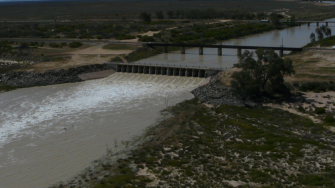
Date: Thursday, October 20, 2016
Project: Eastern Australian Waterbird Survey
Observer: Terry Korn
Cloud shrouded mountains were caressed by our Cessna 206 as we crossed the Blue mountains on a path which would ultimately have us in Broken Hill at the end of the day.
Band four of the Eastern Australian Waterbird Survey takes you from the Myall Lakes on the coast to the Menindee Lakes in far western New South Wales. On the western side of the mountains our first count was on the Cudgegong River arm of the 100% full Burrendong Dam which regulates flows in the Macquarie River. Like all other wetlands to date, there were few waterbirds because of the widespread rain across Eastern Australia over the last three months. Widespread rains mean widespread birds and so on this body of water, we saw a few pelicans, black swans and cormorants.
It was no different along the Macquarie River into Dubbo. Few birds, but a magnificent season which is evident by the prolific crops, abundant green feed and fat cattle. This river, which feeds the Ramsar listed Macquarie Marshes was running strongly due to spillage from Burrendong dam upstream of Wellington.
After refuelling at Dubbo and a short break, we began the long leg to Broken Hill via the Menindee lakes.
It was interesting to see the change in surface water in paddocks as we moved west. From Dubbo to south of Trangie many paddocks had free standing water. But as we moved further west, past Nyngan and Nymagee, surface water disappeared, farm dams were not always full but paddocks were still green. All farm dams had no or very few birds on them.
Water logged paddocks south west of Dubbo. Photo Terry Korn
Land clearing patterns south of Nyngan. Paddocks are green but surface water has disappeared. Photo Terry Korn
Approaching the massive Darling River floodplain east of Menindee, we speculated on whether the Terryawenya Lake complex, filled by Tallywalka Creek from the Darling River, would have any water as a result of the Darling River flow filling Menindee lakes. It was not to be! All lakes in the Terryawenya complex were dry and many had been cropped so we overflew them to tackle the Menindee Lakes which we could see shimmering in the distance. These lakes are classed as Special Environmental Assets of the Murray-Darling Basin and we count them twice to estimate the uncertainty of our counting. We knew we would not land at Broken Hill until we had been in our small single engine plane for 4.5 hrs.
The Darling River floodplain east of the river is dry. Photo Terry Korn
Always contentious as a water storage because of their shallowness and large surface area since construction in the 1960s, it is only now they are filling after three years of being empty, causing severe water restrictions in the city. The city of Broken Hill relies on the lakes for its water supply and the all-important mining industry. The long term plan is to pipe water from the Murray River to ensure supply to the city and industry.
The Darling River entering the Menindee Lakes complex. Photo Terry Korn
The newly filled lakes held few waterbirds, with most on the northern most natural lakes such as Malta and Balaka where pelicans and black swans were beginning to gather. The wonderful lignum communities of Lake Wetherell have not yet begun to produce sufficient food to attract any number of pelicans or cormorants. Just a few pied cormorants. All cormorant species will build up in abundance in a few months when the food web begins to pulse.
Broken Hill’s playground, “Sunset Strip” on Menindee Lake, is anxiously awaiting the water to get to its beach. Photo Terry Korn
Water was pounding into Lake Menindee from the Copi Hollow weir but the bed of the lake was only 70% covered as we squint into the lowering sun without finding any concentration of birds.
Water pours into Menindee Lake. Photo terry Korn
